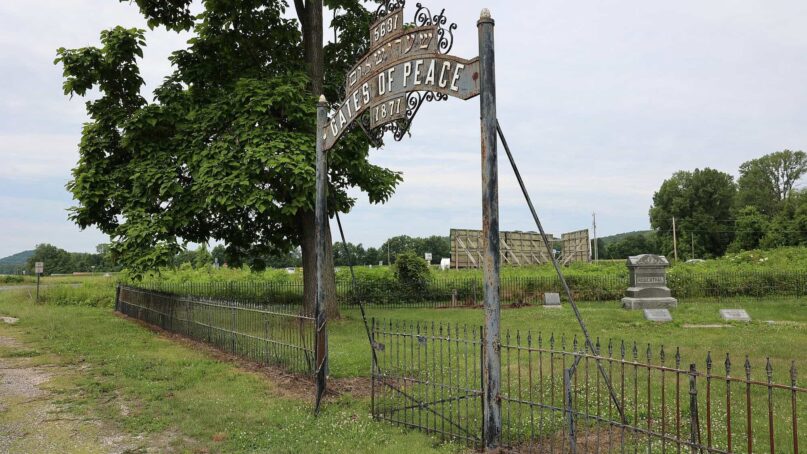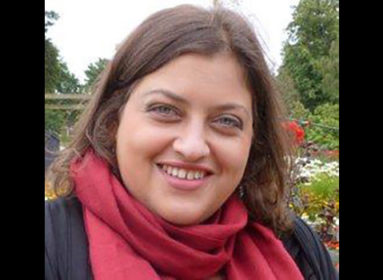
By Bill Motchan
The fall High Holiday season is a time of reflection and renewal and when many Jews visit the graves of loved ones. A secluded Jewish cemetery in Louisiana, Mo., is a special place for descendants of dozens of Jewish residents who made the town their home more than a century ago.
Louisiana, some 90 miles north of St. Louis, has a population of a little more than 3,000. The 200-year-old river town is known for its Victorian streetscape and for 10 buildings on the National Register of Historic Places. Louisiana has another noteworthy distinction: its Jewish history.
The most poignant reminder of a once-vibrant Jewish community in Louisiana is located just west of town on state road NN. That’s where the Gates of Peace Jewish Cemetery sits. The iron gate entrance reads:
GATES OF PEACE — 1871
Gates of Peace is the resting place of 105 Jewish Louisianans. Most were members of families who ran successful dry-goods stores. In the late 1800s, more than a dozen large Jewish families made Louisiana their home and became part of the town’s fabric. They served as Jewish deputies, city councilmen, a county collector and a constable. The town had no synagogue, but residents routinely celebrated Jewish holidays and maintained a Jewish lifestyle.
It wasn’t unusual for Jewish immigrants to move from town to town, seeking opportunities to earn a living. As their businesses prospered, Jewish Louisianans decided to make the town their permanent home. It wasn’t practical to build a synagogue for such a small population, but they saw a real need to create a burial ground. The first burial at Gates of Peace was in 1871. Kate Fishell died there nine days after her first birthday.
Gates of Peace sits on a one-acre tract of land, adjacent to a fire station today. On June 11, 1871, a group of 26 Jewish men (including Ferdinand Fishell, Kate Fishell’s father) gathered in the town library to officially organize the Hebrew Cemetery Association of Louisiana.
Jewish migration to the Midwest
A steady influx of Jewish immigrants from Europe migrated to America in the 19th century. The Jewish population grew rapidly in the United States—from 3,000 in 1820 to 300,000 in 1880. Frequently, they came from Central Europe. The main attraction was the ability to build a better life for their families. America represented the land of opportunity. Many of the new arrivals were German-speaking Jews who settled in small Midwestern towns.
“River traffic was the main mode of transportation before the railroads were established, so the cities along the Mississippi River were developed as river towns,” said Jewish author and historian Cynthia Gensheimer. “They settled in every small town along the Mississippi.”
Their career path often took shape in the clothing and dry-goods business. That choice paid off because they were hard-working and motivated to succeed, Gensheimer said.
“Many of them began by being peddlers,” she said. “There are Horatio Alger stories that begin with a Jewish settler starting with a pack on his back. Then he gets a cart, then he’d become a clerk or set up a little store of his own. In the case of the Younker family, one brother would be at a store and another would be peddling. They had one prosperous store, then they’d set up a satellite store in a neighboring city. They were dealing in different commodities. Hides and furs were a big part of the business.”
Benjamin Younker, who settled in Louisiana, was the eldest of eight brothers. Some of them were in Louisiana as early as 1856. They started with nothing, and initially, one brother would be tending the store while another would be peddling. They moved around but stayed very close. Several brothers were headquartered in Keokuk, Iowa, in the mid-1870s when they decided to set up a branch in Des Moines. They correctly predicted that the railroads would make that city prosperous. The Younker Brothers Department store eventually expanded to 150 stores in the Midwest.
Growth of the Jewish community
Brothers Simon and Marx Lesem helped establish organized Jewish life in Louisiana. They had relatives in Quincy who were leaders there. In 1868, one of the Lesem brothers reported four Jewish families in Louisiana, and in 1870, they started the Hebrew Benevolent Society. The Lesems eventually got fed up with the lack of interest in Judaism displayed by the Jews in Louisiana and returned to their native Germany.
In addition to the Younker’s Louisiana’s Jewish residents included the Genzbergers, Michaels, Morrises, Zuzaks and Walds.
The Wald Brothers Department store was operated by brothers David and Adam Wald. They were also next-door neighbors who lived a half block from their store. Although Louisiana had a Jewish community, finding a suitable spouse was challenging for young Jewish men in town. So Adam ventured to Chicago where he met and courted Sara Liebenstein Hart. They settled in Louisiana, and Sara taught religious school to Jewish children. She also headed up the Louisiana chapter of the National Council of Jewish Women (NCJW).
Competitors and innovators in business
In the 1890s, the retail business in Louisiana was fiercely competitive. Two Jewish store owners—the Walds and Michaels—had stores on Georgia Street, the town’s main thoroughfare. Abraham Wald and Isador Michael were the patriarchs of the two families and their rivalry in business often spilled over to life outside the stores. Every Friday morning in preparation for Shabbat dinner, Jewish families would head to the local fish market. In her autobiography about life in Louisiana, The Pleasure Is Mine, Sara Hart described a weekly occurrence.
“The elder Mr. Michael and the elder Mr. Wald raced to market to buy fish. My father-in-law [Abraham Wald] had the advantage because he lived a block closer. Mr. Michael limped. Each made his way rapidly down the street intent upon getting there first.”
Although they were rivals in business, the Jewish merchants in Louisiana came together to worship. There was no official congregation, but Shabbat services were held on Friday evenings and during the Jewish holidays at the Masonic Temple on Georgia Street. Records show the congregation had 34 members. Isador Michael led services and Isaac Younker was president-secretary-treasurer. Younker doubled as president of Gates of Peace Cemetery.
Merchandising mavens
The Younkers flagship store in Des Moines was known for its tea room restaurant, and in 1939, it boasted Iowa’s first escalator, known as the “electric stairs.” The Zuzaks were also savvy innovators. Family members operated a sundries store in Boonville, Mo., called the Zuzak Wonder Store. Jerry Krueger, a Zuzak descendant now living in Akron, Ohio, offered a bit of family lore about the store.
“Depending on what source you read, the Zuzaks were either the first store to come up with Santa Claus coming to the store the day after Thanksgiving or the first one west of the Mississippi,” Krueger said. “But, yeah, the great irony is that the Jewish merchant is the one who figured out how to extend the Christmas shopping season.”
Two Zuzak sisters, Helen and Amy, eventually took ownership of the store and were successful businesswomen in their own right. They also contributed generously to the neighboring Kemper Military Academy. Bob Bondi, a Zuzak descendant now living in Galesburg, often visited the sisters when he was growing up.
“I remember them quite vividly, and they were always so kind to us,” said Bondi, 72. “In the ’50s and ’60s, we’d visit them every couple of months. I also went to their burials in Louisiana. Amy didn’t marry probably because she had diabetes and went blind very early in life when Helen took care of her.”
The Walds, Younkers and Zuzaks weren’t the only Jewish merchandising mavens in Louisiana. Elias Michael emigrated from Kolmar, Prussia, in 1856. He settled in Quincy, Ill., and in 1867 moved 45 miles south to Louisiana and opened a one-room store. It eventually grew to become one of the best-stocked dry goods stores in northeast Missouri. In 1929, he sold it to J.C. Penney.
Marcus Morris represents another rags-to-riches story—literally. Morris was a rag salesman. He eventually had his own department store. He later branched out into real estate, owning 127 business houses. His net worth was $200,000 when he died at age 59 in 1907. Adjusted for inflation, that’s equivalent to $6.2 million in 2023.
In 1901, Morris was elected president of Gates of Peace, and in an April 1 meeting that year, he proposed that five families (Morris, Wald, Genzberger, Younker and Michael) pay $1 per month towards the cemetery’s “Iron Fence Fund.” The Zuzak, Liebenstein and Strouss families were charged 25 cents per month. The proposal passed and the iron fence is still in place 124 years later.
Jewish life In Louisiana
As the 20th century began, U.S. Census records show the population of Louisiana peaked at 5,131. Jewish residents made up 1.8% of the population. While St. Louis was preparing to host the World’s Fair, up in Louisiana, life moved at a slower pace. Townspeople would take summer excursions on a ferry across the river to Pittsfield, Ill., or watch a horse race at the Pike County Fair. The Wald family regularly attended the local church’s ice-cream socials.
Antisemitism and prejudice against Jews were rare in Louisiana, according to Sara Hart’s autobiography. She and the other Jewish families weren’t excluded from the town’s organizations, although the same couldn’t be said for black Louisianans. Hart described a local non-Jewish family whose daughter fell in love with a Jewish traveling salesman. Her father, a God-fearing man, said since Jews were the chosen people, he gave the union his blessing.
Being Jewish in a small town did require some compromises. In Louisiana, kosher food was unavailable. There was no mikvah. Working on the Sabbath was also a necessity for the Jewish merchants, as Saturday was the busiest shopping day of the week for residents. Sara Hart, speaking at an NCJW meeting in Cleveland in 1900, defended the practice of working on Saturday and observing the Sabbath on Sunday. Her premise and speech won the blessing of her friend Rabbi Leon Harrison from Temple Israel in St. Louis. Orthodox rabbis in Cleveland were far less positive in their review of the concept.
Although Sara Hart’s experience in Louisiana was positive, she left for her native Chicago after her husband, Adam Wald, died unexpectedly in 1901 at the age of 48. She subsequently married Harry Hart (a founder of Hart, Schaffner & Marx) and was a founder of the Chicago Juvenile Court.
The last Jewish Louisianans
Jewish families tended to be large in Louisiana and other small Midwest towns but adult children often remained unmarried. One possible reason was the lack of eligible Jewish spouses. Those who did marry usually found a mate in a larger city. Adult children of the Jewish Louisianan merchants also had less interest in taking over the family business. Large companies like Macy’s, Dillard’s and big-box retailers also made family-owned shops less viable.
Gradually, in the mid-1900s, the Jewish population in the town of Louisiana dwindled and is now nonexistent. The last Jewish resident was Dr. Howard Green, who is originally from New York. He and his second wife moved to Louisiana in 1986 to help care for her family. They ended up staying and enjoyed small-town life. Green moved to Boynton Beach, Fla., eight years ago after his wife died.
“As far as antisemitism in the town, I never encountered any,” said Green, 95. “I was one of the two only surgeons, and we did an awful lot for the community. And financially we helped most of the organizations. My wife was very active in their theater. I went back to Louisiana about five years ago, just to visit. As I was walking down the streets, anybody who saw me came over to say hello. They were so glad to see me. So being a Jew was not a problem.”
His step-granddaughter, Emily Hoffman, was the only Jewish student who attended Louisiana High School in the late 1990s. Hoffman, who now lives in Wisconsin, keeps a kosher home and is Torah-observant. Each week, her family made a one-hour trek to attend a synagogue in Quincy. She said growing up in the area was a positive experience.
“I had a very good childhood,” said Hoffman, 43. “I had a lot of opportunities that I wouldn’t have had in a big city. “My mother would leave out freshly baked goods for the postman. The worker in the grocery store bagging the groceries would know my name. I think the biggest testament would be when my mother died. I was 13 years old, and she had received the ‘Citizen of the Year Award’ the year prior. She was extremely active in Louisiana. And on the day of her funeral, they shut down school and they shut down the main street because the entire town was going to be attending.”
A Jewish legacy
Gates of Peace is now maintained by Pike County. The final burial was on May 12, 1980. Henriette Morris, 88, represented the last family member who created the Hebrew Cemetery Association of Louisiana.
“Those families turned the cemetery over to the county for professional care with a stipulation that only offspring of those families could be buried there,” said Green. “When my wife died, we would have loved to have had her buried there, but we couldn’t do it. We had to bury her in Quincy.”
Today, tall, mature trees provide shade in the center of Gates of Peace. Every year on Memorial Day, flowers are delivered by a local florist and placed on the graves of nine Zuzaks. Bob Bondi calls in the annual order “to honor the Zuzak family.” Unlike Louisiana, his hometown of Galesburg, Ill., has nearly 40 Jewish families, a congregation (Temple Shalom) and a full-time rabbi.
On a hot July day, an SUV parked on the gravel road just outside the cemetery. The (non-Jewish) driver got out, walked to the iron gate entrance and stood in silence for a few minutes. She has no relatives at Gates of Peace. She explained that she found visiting small, historic cemeteries a calming, soothing experience.
This story originally appeared in the St. Louis Jewish Light. Photos and text by Bill Motchan.
PHOTO: Gates of Peace cemetery








 Southern New England Jewish Ledger
Southern New England Jewish Ledger










